Corporate Takeover Decision Making and the Effects on Consolidation Accounting
VerifiedAdded on 2023/04/03
|16
|3196
|219
AI Summary
This report assesses the effects of corporate takeover decision making on consolidation accounting. It discusses equity accounting, intragroup transactions, and NCI disclosure. The report also highlights the importance of accurate financial statements and the relevance of accounting standards.
Contribute Materials
Your contribution can guide someone’s learning journey. Share your
documents today.
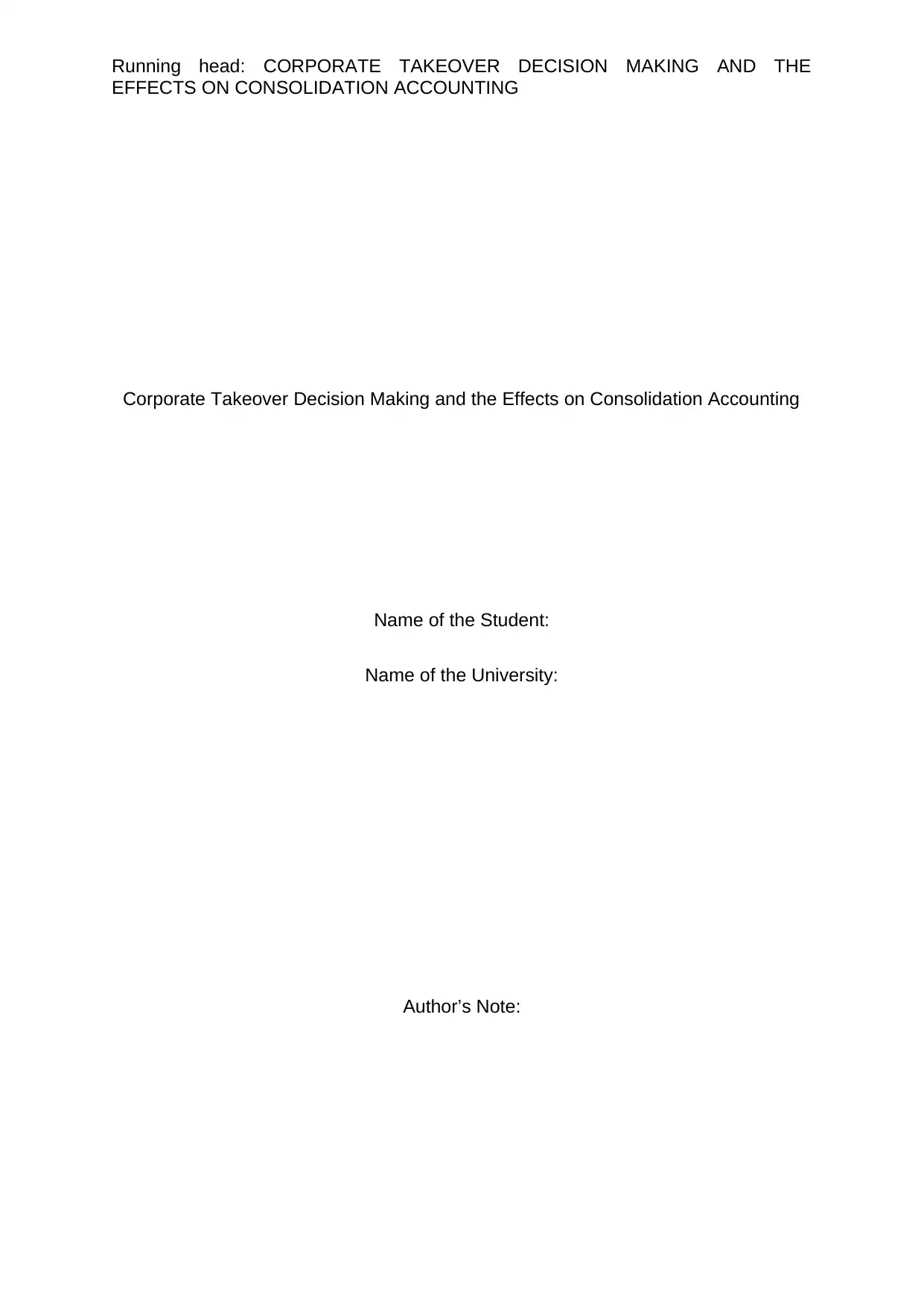
Running head: CORPORATE TAKEOVER DECISION MAKING AND THE
EFFECTS ON CONSOLIDATION ACCOUNTING
Corporate Takeover Decision Making and the Effects on Consolidation Accounting
Name of the Student:
Name of the University:
Author’s Note:
EFFECTS ON CONSOLIDATION ACCOUNTING
Corporate Takeover Decision Making and the Effects on Consolidation Accounting
Name of the Student:
Name of the University:
Author’s Note:
Secure Best Marks with AI Grader
Need help grading? Try our AI Grader for instant feedback on your assignments.

2
CORPORATE TAKEOVER DECISION MAKING AND THE EFFECTS ON
CONSOLIDATION ACCOUNTING
CORPORATE TAKEOVER DECISION MAKING AND THE EFFECTS ON
CONSOLIDATION ACCOUNTING

3
CORPORATE TAKEOVER DECISION MAKING AND THE EFFECTS ON
CONSOLIDATION ACCOUNTING
Table of Contents
Introduction...................................................................................................................2
PART A Response........................................................................................................2
PART B.........................................................................................................................5
PART C.........................................................................................................................8
Conclusion..................................................................................................................11
Reference List.............................................................................................................12
CORPORATE TAKEOVER DECISION MAKING AND THE EFFECTS ON
CONSOLIDATION ACCOUNTING
Table of Contents
Introduction...................................................................................................................2
PART A Response........................................................................................................2
PART B.........................................................................................................................5
PART C.........................................................................................................................8
Conclusion..................................................................................................................11
Reference List.............................................................................................................12
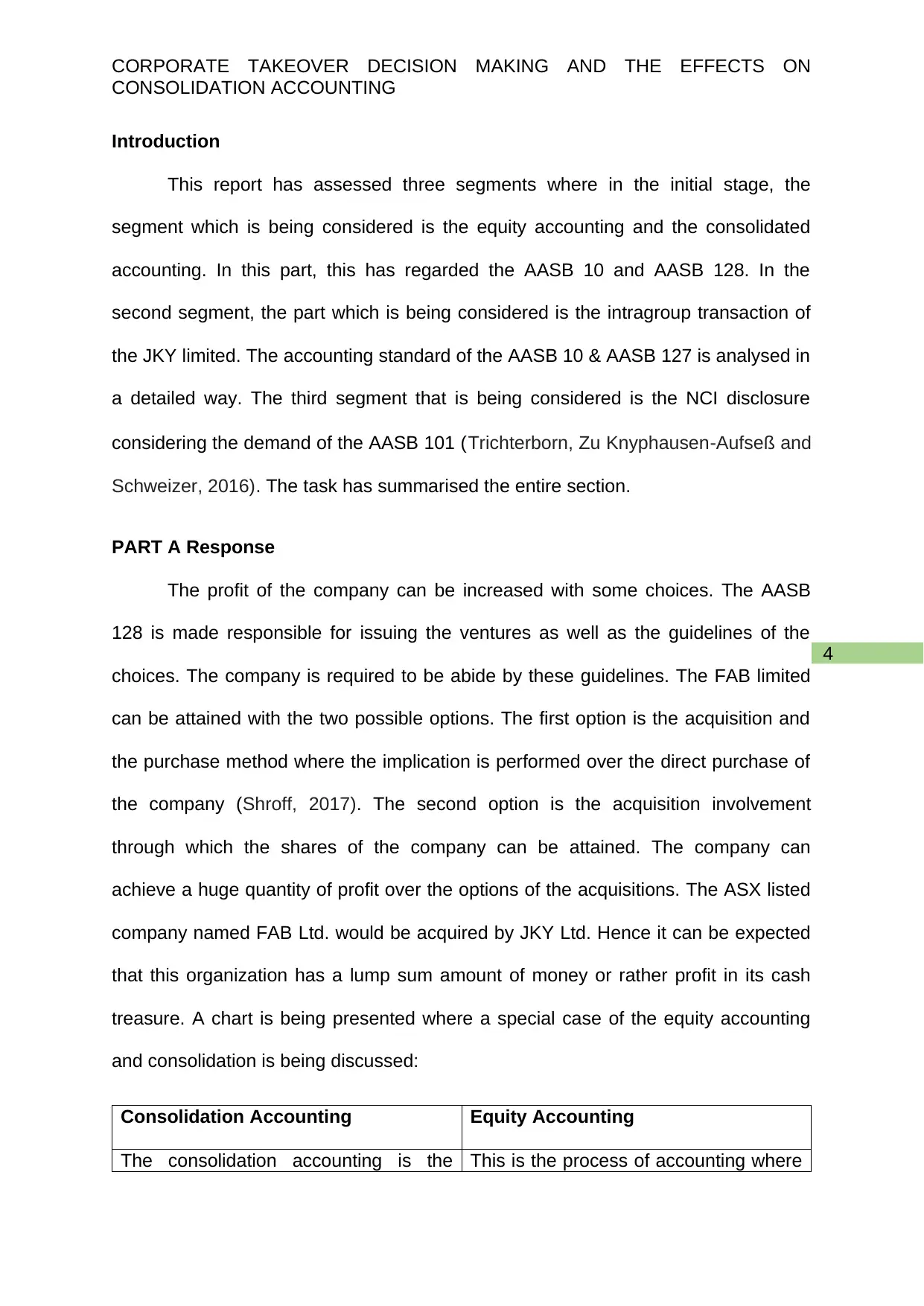
4
CORPORATE TAKEOVER DECISION MAKING AND THE EFFECTS ON
CONSOLIDATION ACCOUNTING
Introduction
This report has assessed three segments where in the initial stage, the
segment which is being considered is the equity accounting and the consolidated
accounting. In this part, this has regarded the AASB 10 and AASB 128. In the
second segment, the part which is being considered is the intragroup transaction of
the JKY limited. The accounting standard of the AASB 10 & AASB 127 is analysed in
a detailed way. The third segment that is being considered is the NCI disclosure
considering the demand of the AASB 101 (Trichterborn, Zu Knyphausen‐Aufseß and
Schweizer, 2016). The task has summarised the entire section.
PART A Response
The profit of the company can be increased with some choices. The AASB
128 is made responsible for issuing the ventures as well as the guidelines of the
choices. The company is required to be abide by these guidelines. The FAB limited
can be attained with the two possible options. The first option is the acquisition and
the purchase method where the implication is performed over the direct purchase of
the company (Shroff, 2017). The second option is the acquisition involvement
through which the shares of the company can be attained. The company can
achieve a huge quantity of profit over the options of the acquisitions. The ASX listed
company named FAB Ltd. would be acquired by JKY Ltd. Hence it can be expected
that this organization has a lump sum amount of money or rather profit in its cash
treasure. A chart is being presented where a special case of the equity accounting
and consolidation is being discussed:
Consolidation Accounting Equity Accounting
The consolidation accounting is the This is the process of accounting where
CORPORATE TAKEOVER DECISION MAKING AND THE EFFECTS ON
CONSOLIDATION ACCOUNTING
Introduction
This report has assessed three segments where in the initial stage, the
segment which is being considered is the equity accounting and the consolidated
accounting. In this part, this has regarded the AASB 10 and AASB 128. In the
second segment, the part which is being considered is the intragroup transaction of
the JKY limited. The accounting standard of the AASB 10 & AASB 127 is analysed in
a detailed way. The third segment that is being considered is the NCI disclosure
considering the demand of the AASB 101 (Trichterborn, Zu Knyphausen‐Aufseß and
Schweizer, 2016). The task has summarised the entire section.
PART A Response
The profit of the company can be increased with some choices. The AASB
128 is made responsible for issuing the ventures as well as the guidelines of the
choices. The company is required to be abide by these guidelines. The FAB limited
can be attained with the two possible options. The first option is the acquisition and
the purchase method where the implication is performed over the direct purchase of
the company (Shroff, 2017). The second option is the acquisition involvement
through which the shares of the company can be attained. The company can
achieve a huge quantity of profit over the options of the acquisitions. The ASX listed
company named FAB Ltd. would be acquired by JKY Ltd. Hence it can be expected
that this organization has a lump sum amount of money or rather profit in its cash
treasure. A chart is being presented where a special case of the equity accounting
and consolidation is being discussed:
Consolidation Accounting Equity Accounting
The consolidation accounting is the This is the process of accounting where
Secure Best Marks with AI Grader
Need help grading? Try our AI Grader for instant feedback on your assignments.
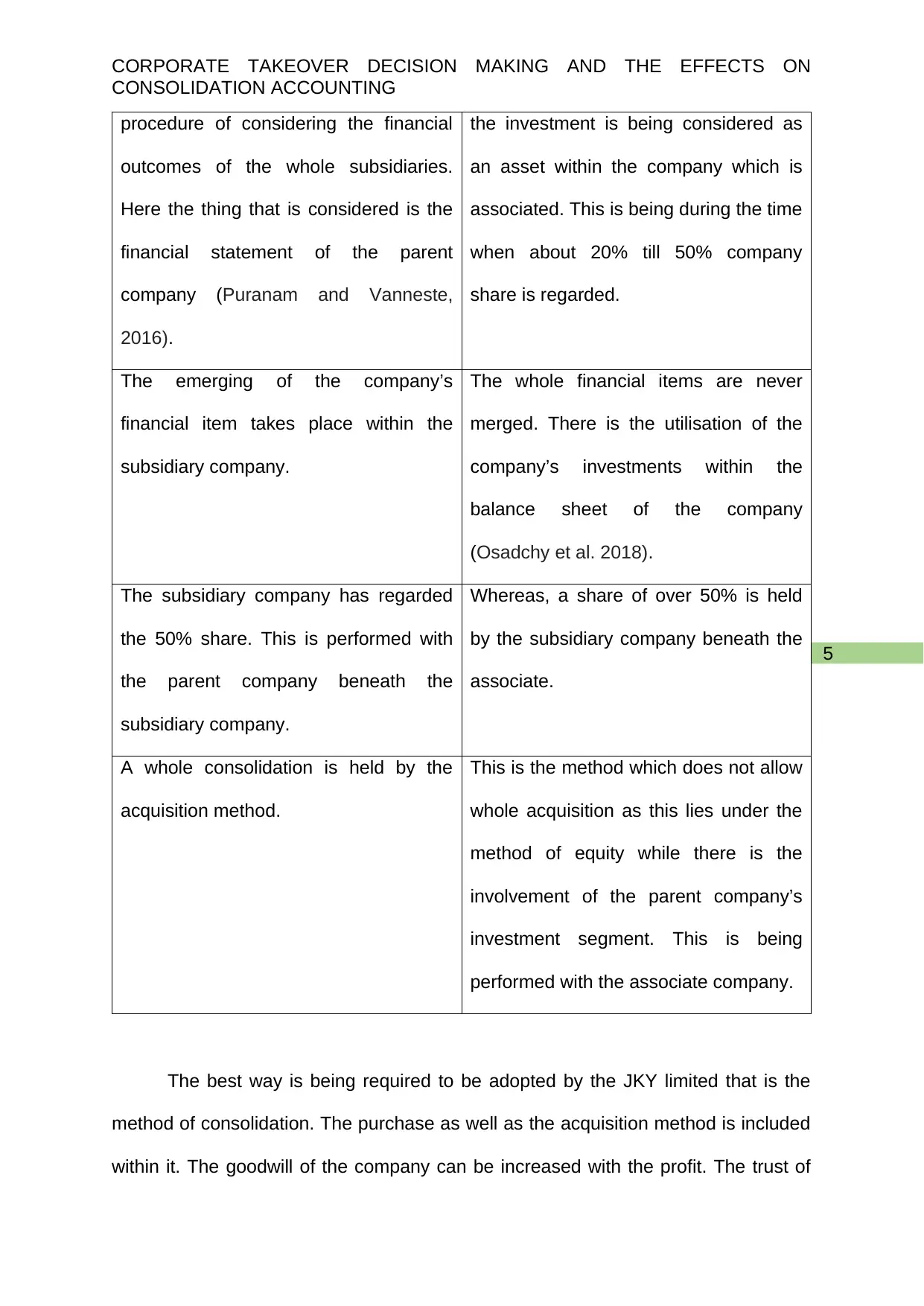
5
CORPORATE TAKEOVER DECISION MAKING AND THE EFFECTS ON
CONSOLIDATION ACCOUNTING
procedure of considering the financial
outcomes of the whole subsidiaries.
Here the thing that is considered is the
financial statement of the parent
company (Puranam and Vanneste,
2016).
the investment is being considered as
an asset within the company which is
associated. This is being during the time
when about 20% till 50% company
share is regarded.
The emerging of the company’s
financial item takes place within the
subsidiary company.
The whole financial items are never
merged. There is the utilisation of the
company’s investments within the
balance sheet of the company
(Osadchy et al. 2018).
The subsidiary company has regarded
the 50% share. This is performed with
the parent company beneath the
subsidiary company.
Whereas, a share of over 50% is held
by the subsidiary company beneath the
associate.
A whole consolidation is held by the
acquisition method.
This is the method which does not allow
whole acquisition as this lies under the
method of equity while there is the
involvement of the parent company’s
investment segment. This is being
performed with the associate company.
The best way is being required to be adopted by the JKY limited that is the
method of consolidation. The purchase as well as the acquisition method is included
within it. The goodwill of the company can be increased with the profit. The trust of
CORPORATE TAKEOVER DECISION MAKING AND THE EFFECTS ON
CONSOLIDATION ACCOUNTING
procedure of considering the financial
outcomes of the whole subsidiaries.
Here the thing that is considered is the
financial statement of the parent
company (Puranam and Vanneste,
2016).
the investment is being considered as
an asset within the company which is
associated. This is being during the time
when about 20% till 50% company
share is regarded.
The emerging of the company’s
financial item takes place within the
subsidiary company.
The whole financial items are never
merged. There is the utilisation of the
company’s investments within the
balance sheet of the company
(Osadchy et al. 2018).
The subsidiary company has regarded
the 50% share. This is performed with
the parent company beneath the
subsidiary company.
Whereas, a share of over 50% is held
by the subsidiary company beneath the
associate.
A whole consolidation is held by the
acquisition method.
This is the method which does not allow
whole acquisition as this lies under the
method of equity while there is the
involvement of the parent company’s
investment segment. This is being
performed with the associate company.
The best way is being required to be adopted by the JKY limited that is the
method of consolidation. The purchase as well as the acquisition method is included
within it. The goodwill of the company can be increased with the profit. The trust of
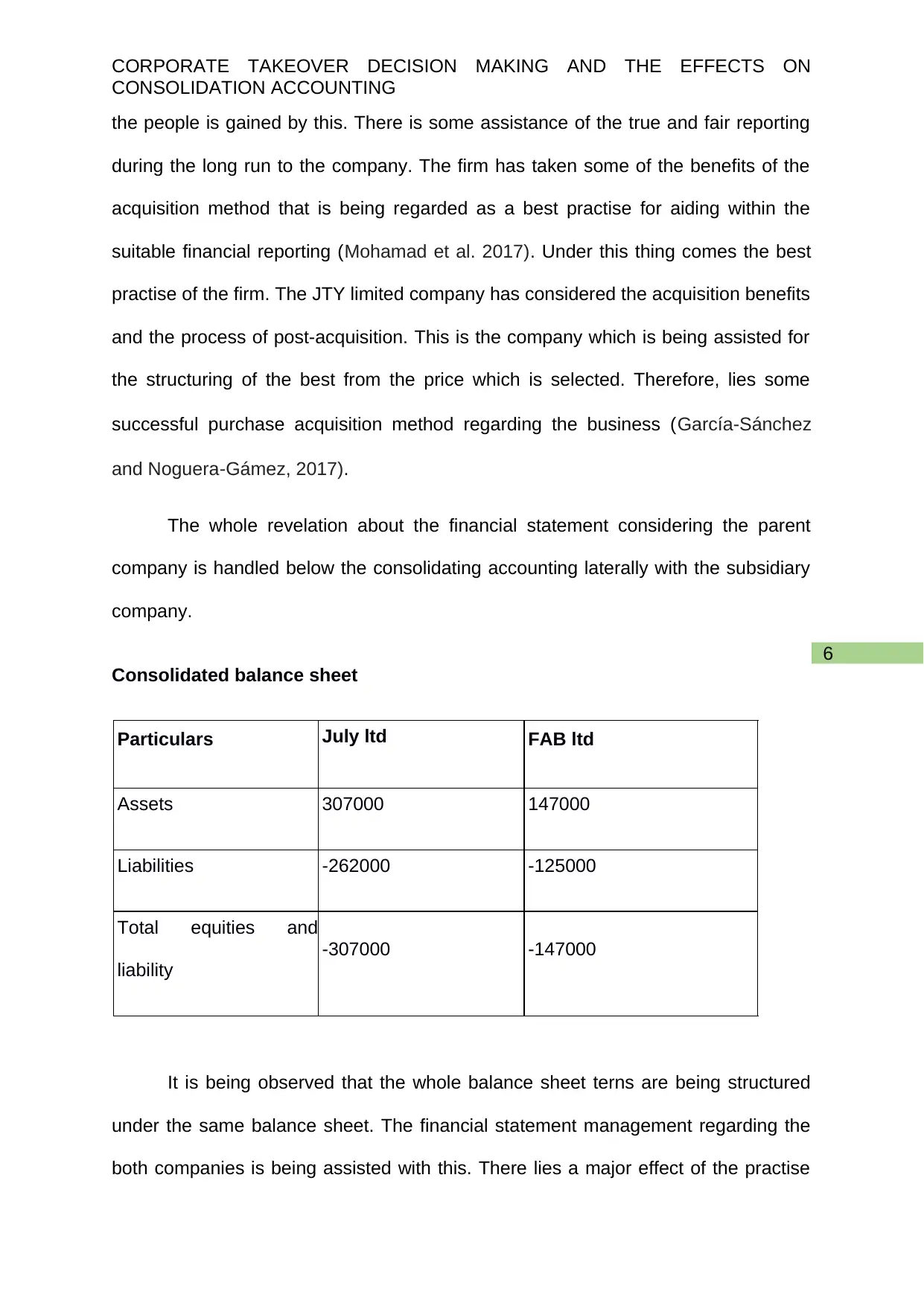
6
CORPORATE TAKEOVER DECISION MAKING AND THE EFFECTS ON
CONSOLIDATION ACCOUNTING
the people is gained by this. There is some assistance of the true and fair reporting
during the long run to the company. The firm has taken some of the benefits of the
acquisition method that is being regarded as a best practise for aiding within the
suitable financial reporting (Mohamad et al. 2017). Under this thing comes the best
practise of the firm. The JTY limited company has considered the acquisition benefits
and the process of post-acquisition. This is the company which is being assisted for
the structuring of the best from the price which is selected. Therefore, lies some
successful purchase acquisition method regarding the business (García‐Sánchez
and Noguera‐Gámez, 2017).
The whole revelation about the financial statement considering the parent
company is handled below the consolidating accounting laterally with the subsidiary
company.
Consolidated balance sheet
Particulars July ltd FAB ltd
Assets 307000 147000
Liabilities -262000 -125000
Total equities and
liability
-307000 -147000
It is being observed that the whole balance sheet terns are being structured
under the same balance sheet. The financial statement management regarding the
both companies is being assisted with this. There lies a major effect of the practise
CORPORATE TAKEOVER DECISION MAKING AND THE EFFECTS ON
CONSOLIDATION ACCOUNTING
the people is gained by this. There is some assistance of the true and fair reporting
during the long run to the company. The firm has taken some of the benefits of the
acquisition method that is being regarded as a best practise for aiding within the
suitable financial reporting (Mohamad et al. 2017). Under this thing comes the best
practise of the firm. The JTY limited company has considered the acquisition benefits
and the process of post-acquisition. This is the company which is being assisted for
the structuring of the best from the price which is selected. Therefore, lies some
successful purchase acquisition method regarding the business (García‐Sánchez
and Noguera‐Gámez, 2017).
The whole revelation about the financial statement considering the parent
company is handled below the consolidating accounting laterally with the subsidiary
company.
Consolidated balance sheet
Particulars July ltd FAB ltd
Assets 307000 147000
Liabilities -262000 -125000
Total equities and
liability
-307000 -147000
It is being observed that the whole balance sheet terns are being structured
under the same balance sheet. The financial statement management regarding the
both companies is being assisted with this. There lies a major effect of the practise
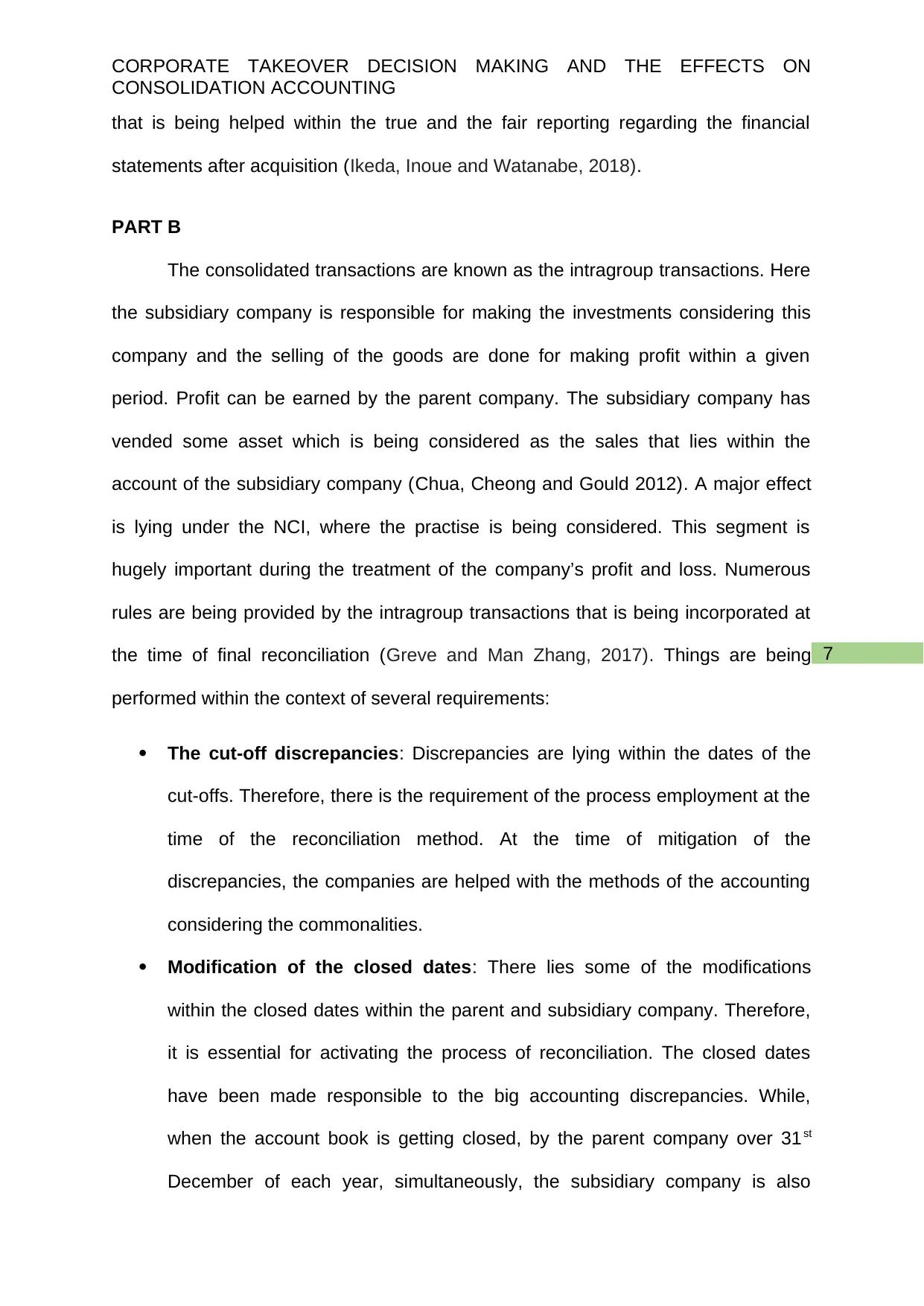
7
CORPORATE TAKEOVER DECISION MAKING AND THE EFFECTS ON
CONSOLIDATION ACCOUNTING
that is being helped within the true and the fair reporting regarding the financial
statements after acquisition (Ikeda, Inoue and Watanabe, 2018).
PART B
The consolidated transactions are known as the intragroup transactions. Here
the subsidiary company is responsible for making the investments considering this
company and the selling of the goods are done for making profit within a given
period. Profit can be earned by the parent company. The subsidiary company has
vended some asset which is being considered as the sales that lies within the
account of the subsidiary company (Chua, Cheong and Gould 2012). A major effect
is lying under the NCI, where the practise is being considered. This segment is
hugely important during the treatment of the company’s profit and loss. Numerous
rules are being provided by the intragroup transactions that is being incorporated at
the time of final reconciliation (Greve and Man Zhang, 2017). Things are being
performed within the context of several requirements:
The cut-off discrepancies: Discrepancies are lying within the dates of the
cut-offs. Therefore, there is the requirement of the process employment at the
time of the reconciliation method. At the time of mitigation of the
discrepancies, the companies are helped with the methods of the accounting
considering the commonalities.
Modification of the closed dates: There lies some of the modifications
within the closed dates within the parent and subsidiary company. Therefore,
it is essential for activating the process of reconciliation. The closed dates
have been made responsible to the big accounting discrepancies. While,
when the account book is getting closed, by the parent company over 31st
December of each year, simultaneously, the subsidiary company is also
CORPORATE TAKEOVER DECISION MAKING AND THE EFFECTS ON
CONSOLIDATION ACCOUNTING
that is being helped within the true and the fair reporting regarding the financial
statements after acquisition (Ikeda, Inoue and Watanabe, 2018).
PART B
The consolidated transactions are known as the intragroup transactions. Here
the subsidiary company is responsible for making the investments considering this
company and the selling of the goods are done for making profit within a given
period. Profit can be earned by the parent company. The subsidiary company has
vended some asset which is being considered as the sales that lies within the
account of the subsidiary company (Chua, Cheong and Gould 2012). A major effect
is lying under the NCI, where the practise is being considered. This segment is
hugely important during the treatment of the company’s profit and loss. Numerous
rules are being provided by the intragroup transactions that is being incorporated at
the time of final reconciliation (Greve and Man Zhang, 2017). Things are being
performed within the context of several requirements:
The cut-off discrepancies: Discrepancies are lying within the dates of the
cut-offs. Therefore, there is the requirement of the process employment at the
time of the reconciliation method. At the time of mitigation of the
discrepancies, the companies are helped with the methods of the accounting
considering the commonalities.
Modification of the closed dates: There lies some of the modifications
within the closed dates within the parent and subsidiary company. Therefore,
it is essential for activating the process of reconciliation. The closed dates
have been made responsible to the big accounting discrepancies. While,
when the account book is getting closed, by the parent company over 31st
December of each year, simultaneously, the subsidiary company is also
Paraphrase This Document
Need a fresh take? Get an instant paraphrase of this document with our AI Paraphraser
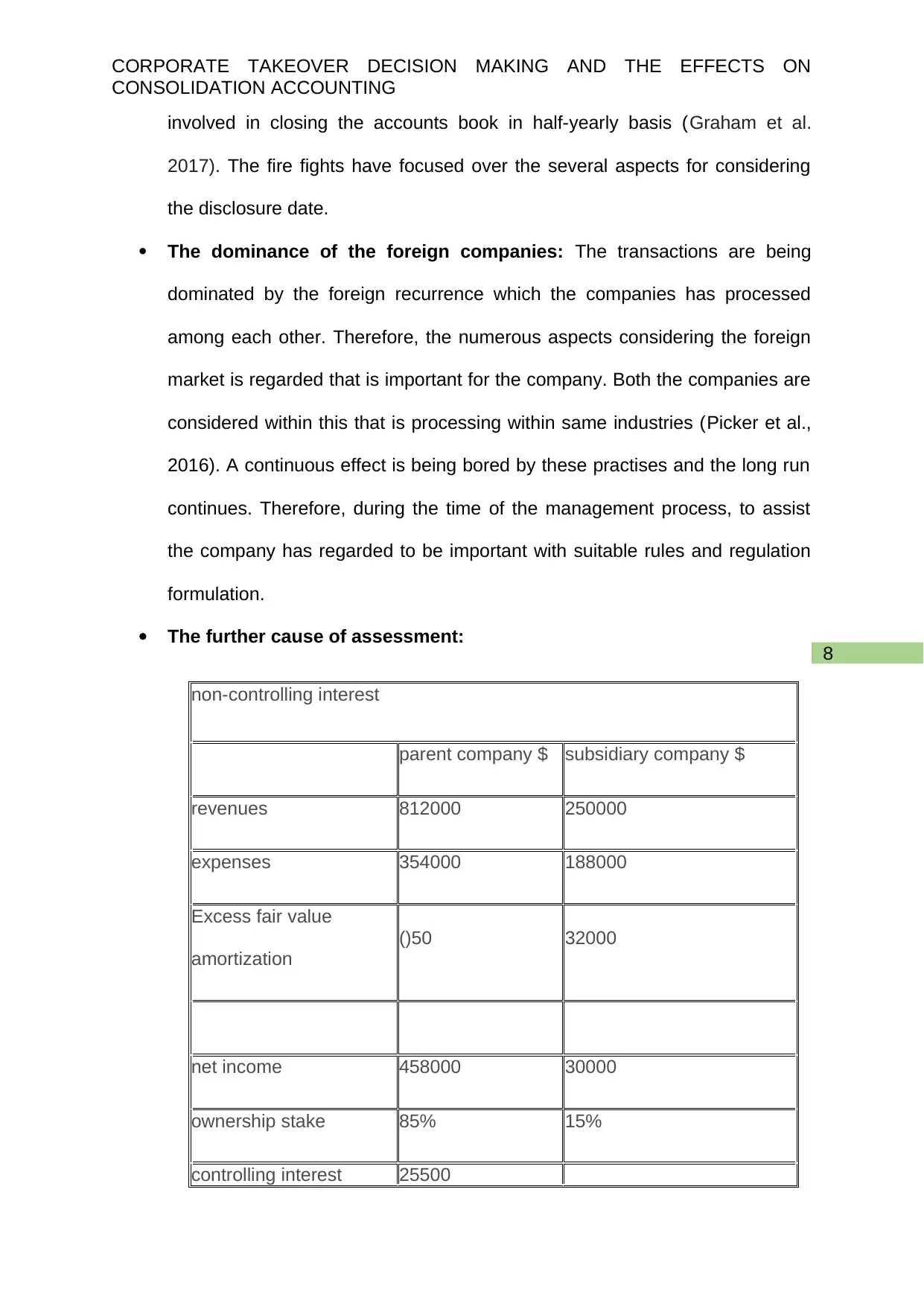
8
CORPORATE TAKEOVER DECISION MAKING AND THE EFFECTS ON
CONSOLIDATION ACCOUNTING
involved in closing the accounts book in half-yearly basis (Graham et al.
2017). The fire fights have focused over the several aspects for considering
the disclosure date.
The dominance of the foreign companies: The transactions are being
dominated by the foreign recurrence which the companies has processed
among each other. Therefore, the numerous aspects considering the foreign
market is regarded that is important for the company. Both the companies are
considered within this that is processing within same industries (Picker et al.,
2016). A continuous effect is being bored by these practises and the long run
continues. Therefore, during the time of the management process, to assist
the company has regarded to be important with suitable rules and regulation
formulation.
The further cause of assessment:
non-controlling interest
parent company $ subsidiary company $
revenues 812000 250000
expenses 354000 188000
Excess fair value
amortization
()50 32000
net income 458000 30000
ownership stake 85% 15%
controlling interest 25500
CORPORATE TAKEOVER DECISION MAKING AND THE EFFECTS ON
CONSOLIDATION ACCOUNTING
involved in closing the accounts book in half-yearly basis (Graham et al.
2017). The fire fights have focused over the several aspects for considering
the disclosure date.
The dominance of the foreign companies: The transactions are being
dominated by the foreign recurrence which the companies has processed
among each other. Therefore, the numerous aspects considering the foreign
market is regarded that is important for the company. Both the companies are
considered within this that is processing within same industries (Picker et al.,
2016). A continuous effect is being bored by these practises and the long run
continues. Therefore, during the time of the management process, to assist
the company has regarded to be important with suitable rules and regulation
formulation.
The further cause of assessment:
non-controlling interest
parent company $ subsidiary company $
revenues 812000 250000
expenses 354000 188000
Excess fair value
amortization
()50 32000
net income 458000 30000
ownership stake 85% 15%
controlling interest 25500
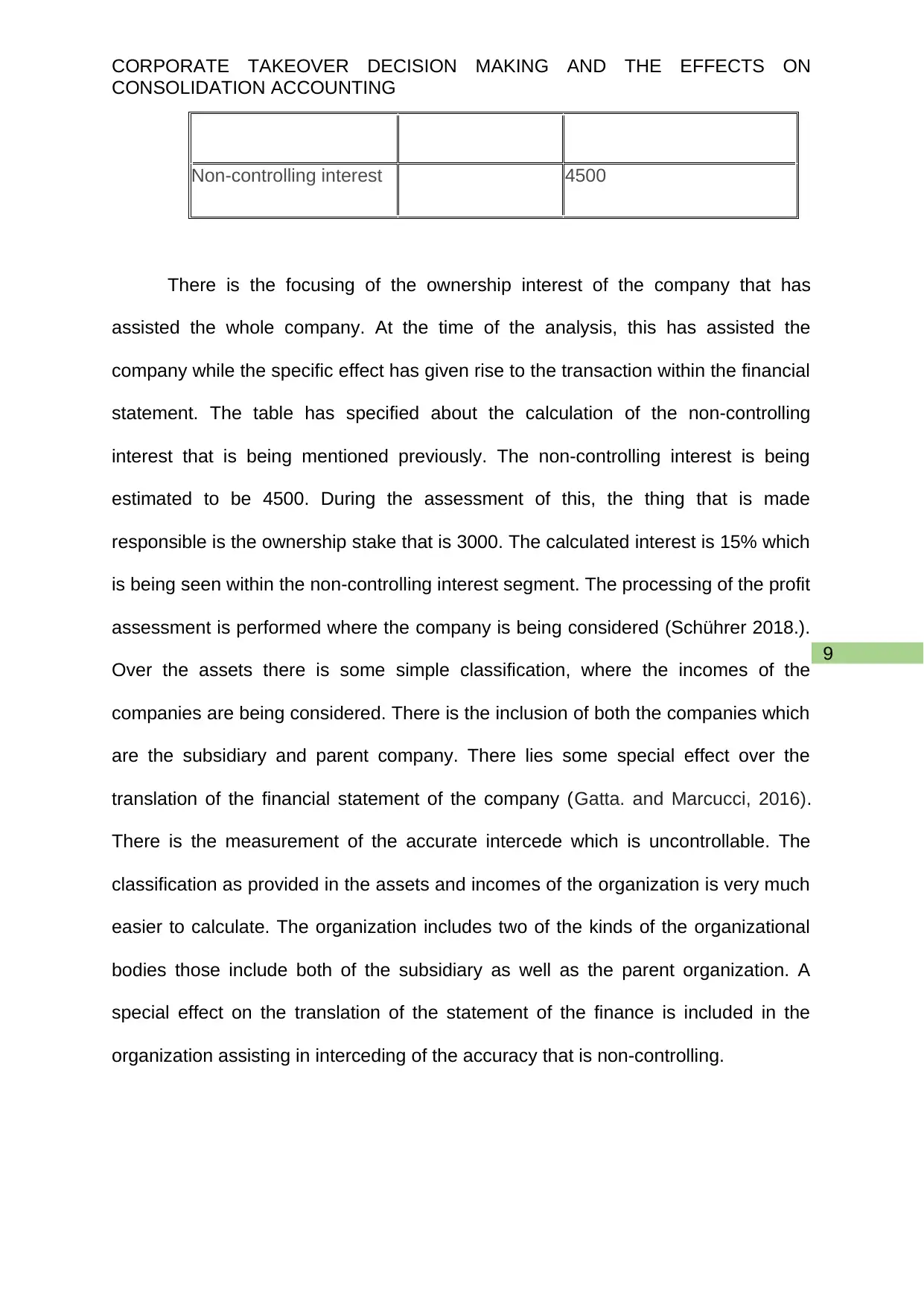
9
CORPORATE TAKEOVER DECISION MAKING AND THE EFFECTS ON
CONSOLIDATION ACCOUNTING
Non-controlling interest 4500
There is the focusing of the ownership interest of the company that has
assisted the whole company. At the time of the analysis, this has assisted the
company while the specific effect has given rise to the transaction within the financial
statement. The table has specified about the calculation of the non-controlling
interest that is being mentioned previously. The non-controlling interest is being
estimated to be 4500. During the assessment of this, the thing that is made
responsible is the ownership stake that is 3000. The calculated interest is 15% which
is being seen within the non-controlling interest segment. The processing of the profit
assessment is performed where the company is being considered (Schührer 2018.).
Over the assets there is some simple classification, where the incomes of the
companies are being considered. There is the inclusion of both the companies which
are the subsidiary and parent company. There lies some special effect over the
translation of the financial statement of the company (Gatta. and Marcucci, 2016).
There is the measurement of the accurate intercede which is uncontrollable. The
classification as provided in the assets and incomes of the organization is very much
easier to calculate. The organization includes two of the kinds of the organizational
bodies those include both of the subsidiary as well as the parent organization. A
special effect on the translation of the statement of the finance is included in the
organization assisting in interceding of the accuracy that is non-controlling.
CORPORATE TAKEOVER DECISION MAKING AND THE EFFECTS ON
CONSOLIDATION ACCOUNTING
Non-controlling interest 4500
There is the focusing of the ownership interest of the company that has
assisted the whole company. At the time of the analysis, this has assisted the
company while the specific effect has given rise to the transaction within the financial
statement. The table has specified about the calculation of the non-controlling
interest that is being mentioned previously. The non-controlling interest is being
estimated to be 4500. During the assessment of this, the thing that is made
responsible is the ownership stake that is 3000. The calculated interest is 15% which
is being seen within the non-controlling interest segment. The processing of the profit
assessment is performed where the company is being considered (Schührer 2018.).
Over the assets there is some simple classification, where the incomes of the
companies are being considered. There is the inclusion of both the companies which
are the subsidiary and parent company. There lies some special effect over the
translation of the financial statement of the company (Gatta. and Marcucci, 2016).
There is the measurement of the accurate intercede which is uncontrollable. The
classification as provided in the assets and incomes of the organization is very much
easier to calculate. The organization includes two of the kinds of the organizational
bodies those include both of the subsidiary as well as the parent organization. A
special effect on the translation of the statement of the finance is included in the
organization assisting in interceding of the accuracy that is non-controlling.
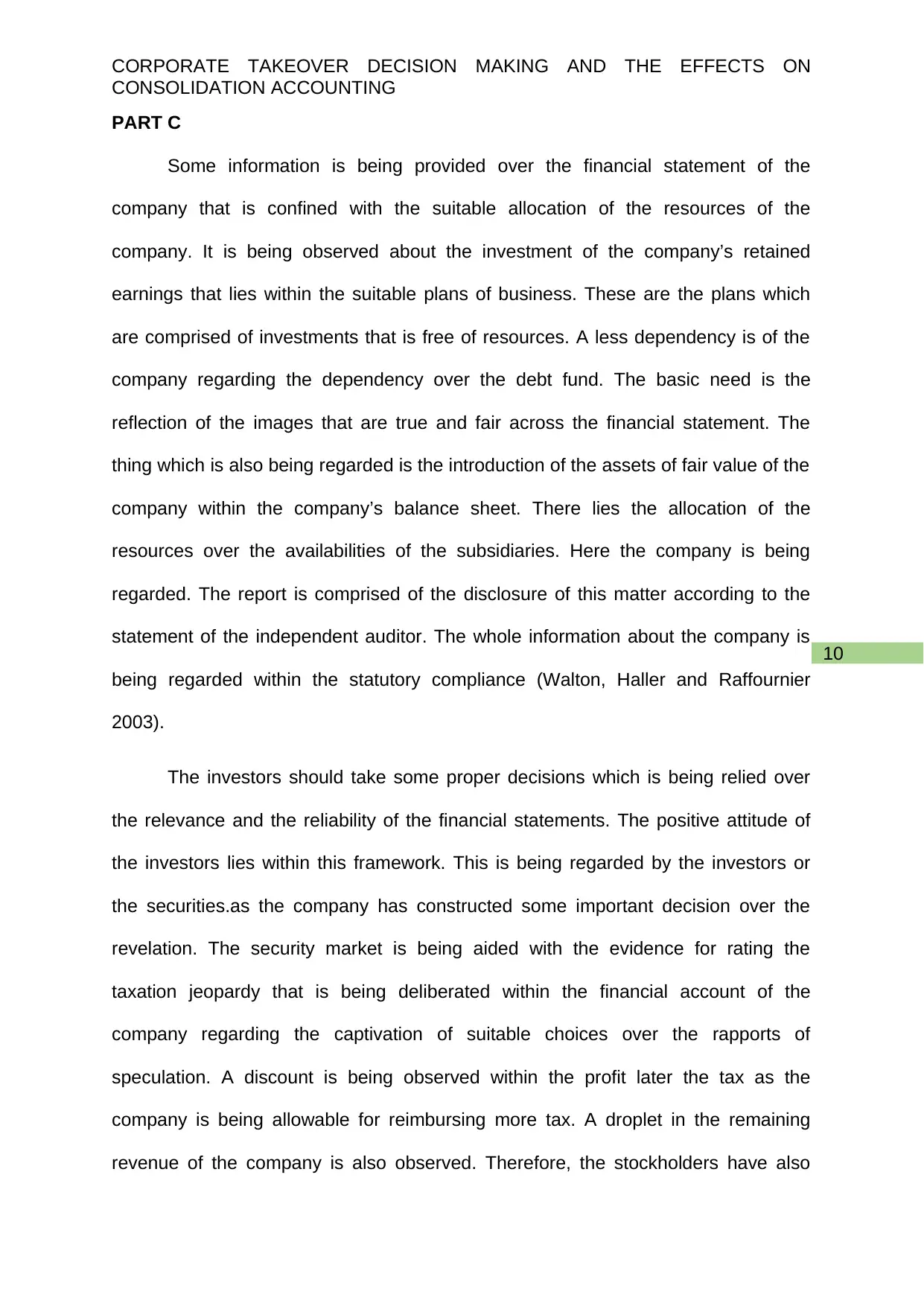
10
CORPORATE TAKEOVER DECISION MAKING AND THE EFFECTS ON
CONSOLIDATION ACCOUNTING
PART C
Some information is being provided over the financial statement of the
company that is confined with the suitable allocation of the resources of the
company. It is being observed about the investment of the company’s retained
earnings that lies within the suitable plans of business. These are the plans which
are comprised of investments that is free of resources. A less dependency is of the
company regarding the dependency over the debt fund. The basic need is the
reflection of the images that are true and fair across the financial statement. The
thing which is also being regarded is the introduction of the assets of fair value of the
company within the company’s balance sheet. There lies the allocation of the
resources over the availabilities of the subsidiaries. Here the company is being
regarded. The report is comprised of the disclosure of this matter according to the
statement of the independent auditor. The whole information about the company is
being regarded within the statutory compliance (Walton, Haller and Raffournier
2003).
The investors should take some proper decisions which is being relied over
the relevance and the reliability of the financial statements. The positive attitude of
the investors lies within this framework. This is being regarded by the investors or
the securities.as the company has constructed some important decision over the
revelation. The security market is being aided with the evidence for rating the
taxation jeopardy that is being deliberated within the financial account of the
company regarding the captivation of suitable choices over the rapports of
speculation. A discount is being observed within the profit later the tax as the
company is being allowable for reimbursing more tax. A droplet in the remaining
revenue of the company is also observed. Therefore, the stockholders have also
CORPORATE TAKEOVER DECISION MAKING AND THE EFFECTS ON
CONSOLIDATION ACCOUNTING
PART C
Some information is being provided over the financial statement of the
company that is confined with the suitable allocation of the resources of the
company. It is being observed about the investment of the company’s retained
earnings that lies within the suitable plans of business. These are the plans which
are comprised of investments that is free of resources. A less dependency is of the
company regarding the dependency over the debt fund. The basic need is the
reflection of the images that are true and fair across the financial statement. The
thing which is also being regarded is the introduction of the assets of fair value of the
company within the company’s balance sheet. There lies the allocation of the
resources over the availabilities of the subsidiaries. Here the company is being
regarded. The report is comprised of the disclosure of this matter according to the
statement of the independent auditor. The whole information about the company is
being regarded within the statutory compliance (Walton, Haller and Raffournier
2003).
The investors should take some proper decisions which is being relied over
the relevance and the reliability of the financial statements. The positive attitude of
the investors lies within this framework. This is being regarded by the investors or
the securities.as the company has constructed some important decision over the
revelation. The security market is being aided with the evidence for rating the
taxation jeopardy that is being deliberated within the financial account of the
company regarding the captivation of suitable choices over the rapports of
speculation. A discount is being observed within the profit later the tax as the
company is being allowable for reimbursing more tax. A droplet in the remaining
revenue of the company is also observed. Therefore, the stockholders have also
Secure Best Marks with AI Grader
Need help grading? Try our AI Grader for instant feedback on your assignments.
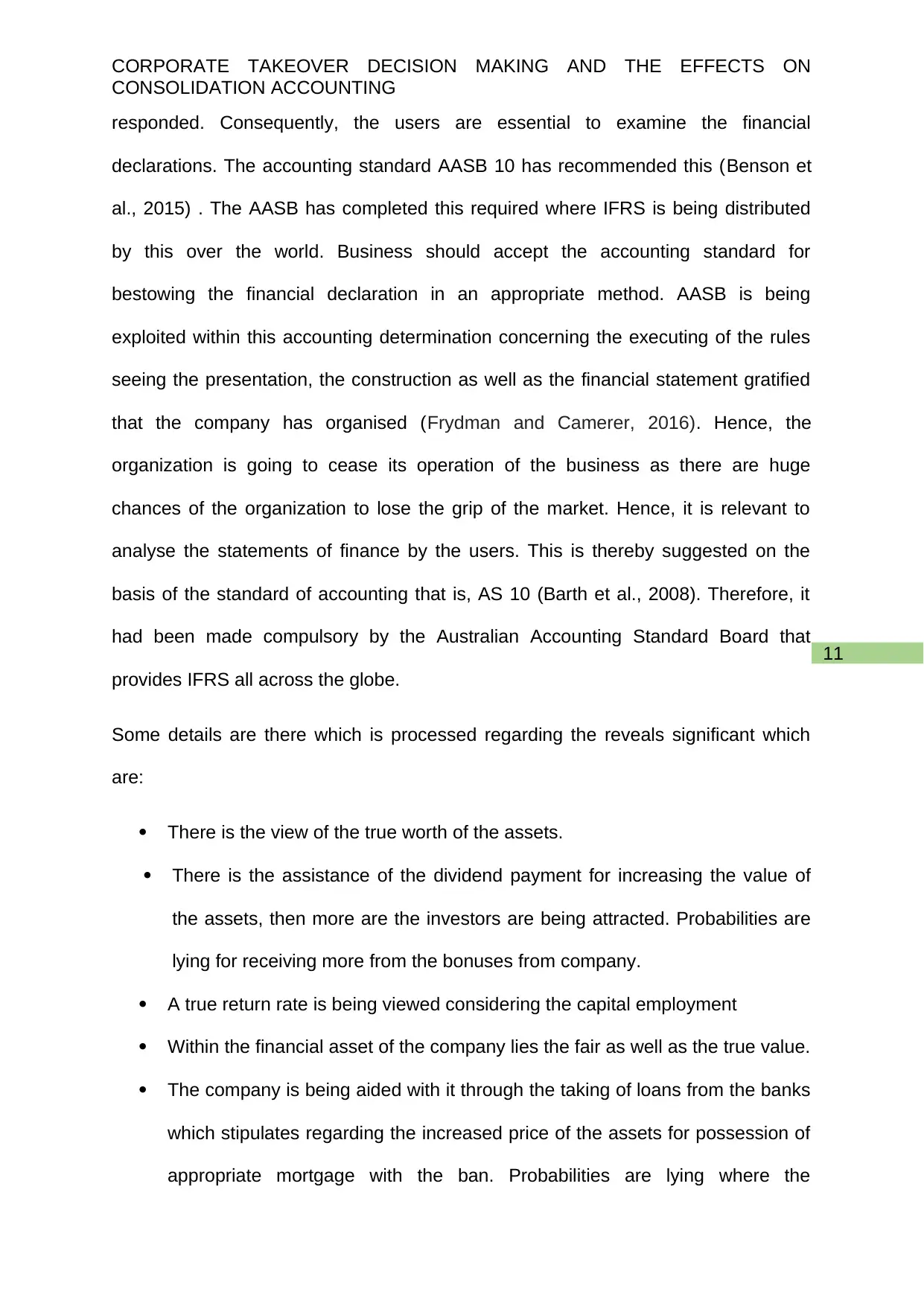
11
CORPORATE TAKEOVER DECISION MAKING AND THE EFFECTS ON
CONSOLIDATION ACCOUNTING
responded. Consequently, the users are essential to examine the financial
declarations. The accounting standard AASB 10 has recommended this (Benson et
al., 2015) . The AASB has completed this required where IFRS is being distributed
by this over the world. Business should accept the accounting standard for
bestowing the financial declaration in an appropriate method. AASB is being
exploited within this accounting determination concerning the executing of the rules
seeing the presentation, the construction as well as the financial statement gratified
that the company has organised (Frydman and Camerer, 2016). Hence, the
organization is going to cease its operation of the business as there are huge
chances of the organization to lose the grip of the market. Hence, it is relevant to
analyse the statements of finance by the users. This is thereby suggested on the
basis of the standard of accounting that is, AS 10 (Barth et al., 2008). Therefore, it
had been made compulsory by the Australian Accounting Standard Board that
provides IFRS all across the globe.
Some details are there which is processed regarding the reveals significant which
are:
There is the view of the true worth of the assets.
There is the assistance of the dividend payment for increasing the value of
the assets, then more are the investors are being attracted. Probabilities are
lying for receiving more from the bonuses from company.
A true return rate is being viewed considering the capital employment
Within the financial asset of the company lies the fair as well as the true value.
The company is being aided with it through the taking of loans from the banks
which stipulates regarding the increased price of the assets for possession of
appropriate mortgage with the ban. Probabilities are lying where the
CORPORATE TAKEOVER DECISION MAKING AND THE EFFECTS ON
CONSOLIDATION ACCOUNTING
responded. Consequently, the users are essential to examine the financial
declarations. The accounting standard AASB 10 has recommended this (Benson et
al., 2015) . The AASB has completed this required where IFRS is being distributed
by this over the world. Business should accept the accounting standard for
bestowing the financial declaration in an appropriate method. AASB is being
exploited within this accounting determination concerning the executing of the rules
seeing the presentation, the construction as well as the financial statement gratified
that the company has organised (Frydman and Camerer, 2016). Hence, the
organization is going to cease its operation of the business as there are huge
chances of the organization to lose the grip of the market. Hence, it is relevant to
analyse the statements of finance by the users. This is thereby suggested on the
basis of the standard of accounting that is, AS 10 (Barth et al., 2008). Therefore, it
had been made compulsory by the Australian Accounting Standard Board that
provides IFRS all across the globe.
Some details are there which is processed regarding the reveals significant which
are:
There is the view of the true worth of the assets.
There is the assistance of the dividend payment for increasing the value of
the assets, then more are the investors are being attracted. Probabilities are
lying for receiving more from the bonuses from company.
A true return rate is being viewed considering the capital employment
Within the financial asset of the company lies the fair as well as the true value.
The company is being aided with it through the taking of loans from the banks
which stipulates regarding the increased price of the assets for possession of
appropriate mortgage with the ban. Probabilities are lying where the
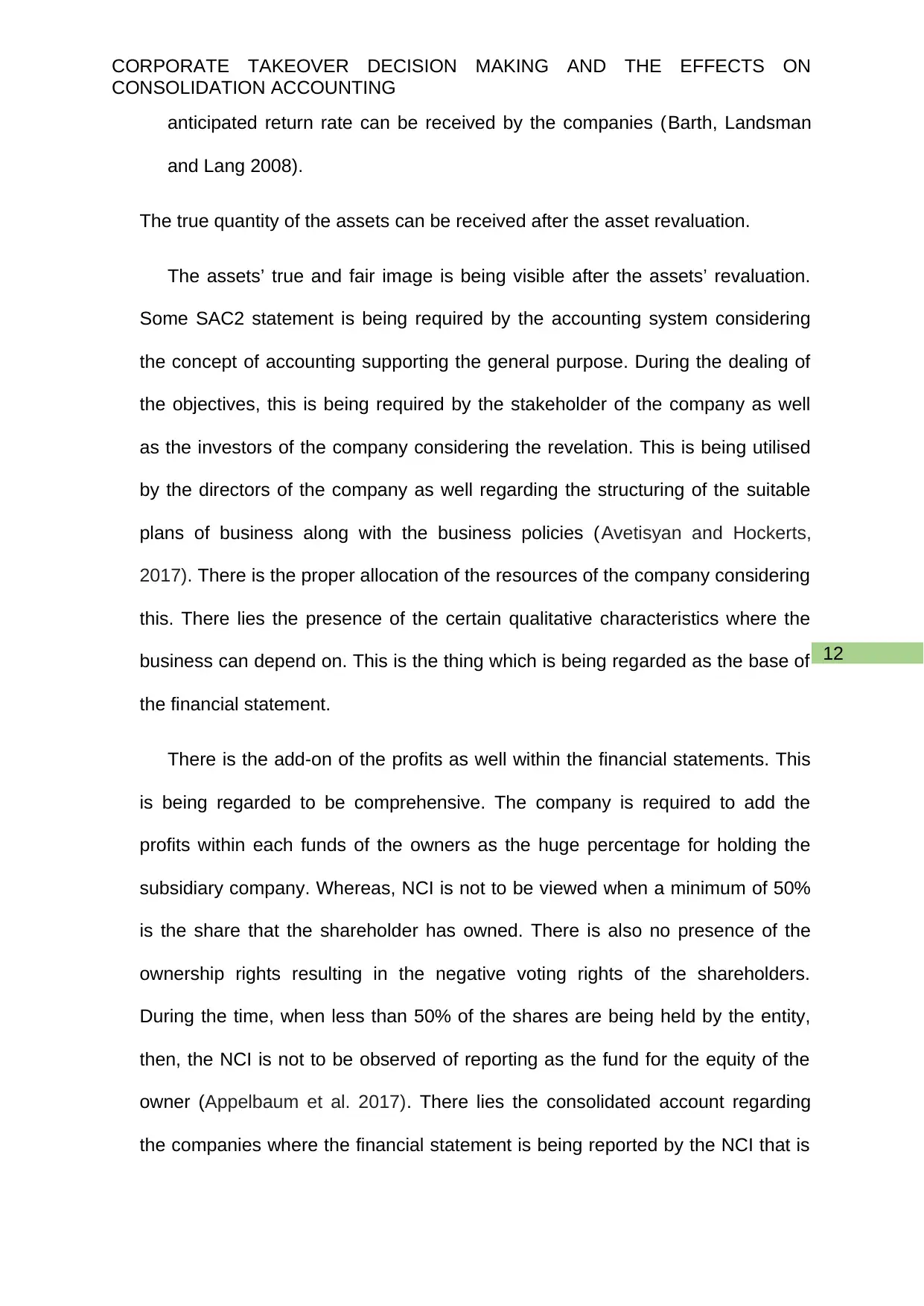
12
CORPORATE TAKEOVER DECISION MAKING AND THE EFFECTS ON
CONSOLIDATION ACCOUNTING
anticipated return rate can be received by the companies (Barth, Landsman
and Lang 2008).
The true quantity of the assets can be received after the asset revaluation.
The assets’ true and fair image is being visible after the assets’ revaluation.
Some SAC2 statement is being required by the accounting system considering
the concept of accounting supporting the general purpose. During the dealing of
the objectives, this is being required by the stakeholder of the company as well
as the investors of the company considering the revelation. This is being utilised
by the directors of the company as well regarding the structuring of the suitable
plans of business along with the business policies (Avetisyan and Hockerts,
2017). There is the proper allocation of the resources of the company considering
this. There lies the presence of the certain qualitative characteristics where the
business can depend on. This is the thing which is being regarded as the base of
the financial statement.
There is the add-on of the profits as well within the financial statements. This
is being regarded to be comprehensive. The company is required to add the
profits within each funds of the owners as the huge percentage for holding the
subsidiary company. Whereas, NCI is not to be viewed when a minimum of 50%
is the share that the shareholder has owned. There is also no presence of the
ownership rights resulting in the negative voting rights of the shareholders.
During the time, when less than 50% of the shares are being held by the entity,
then, the NCI is not to be observed of reporting as the fund for the equity of the
owner (Appelbaum et al. 2017). There lies the consolidated account regarding
the companies where the financial statement is being reported by the NCI that is
CORPORATE TAKEOVER DECISION MAKING AND THE EFFECTS ON
CONSOLIDATION ACCOUNTING
anticipated return rate can be received by the companies (Barth, Landsman
and Lang 2008).
The true quantity of the assets can be received after the asset revaluation.
The assets’ true and fair image is being visible after the assets’ revaluation.
Some SAC2 statement is being required by the accounting system considering
the concept of accounting supporting the general purpose. During the dealing of
the objectives, this is being required by the stakeholder of the company as well
as the investors of the company considering the revelation. This is being utilised
by the directors of the company as well regarding the structuring of the suitable
plans of business along with the business policies (Avetisyan and Hockerts,
2017). There is the proper allocation of the resources of the company considering
this. There lies the presence of the certain qualitative characteristics where the
business can depend on. This is the thing which is being regarded as the base of
the financial statement.
There is the add-on of the profits as well within the financial statements. This
is being regarded to be comprehensive. The company is required to add the
profits within each funds of the owners as the huge percentage for holding the
subsidiary company. Whereas, NCI is not to be viewed when a minimum of 50%
is the share that the shareholder has owned. There is also no presence of the
ownership rights resulting in the negative voting rights of the shareholders.
During the time, when less than 50% of the shares are being held by the entity,
then, the NCI is not to be observed of reporting as the fund for the equity of the
owner (Appelbaum et al. 2017). There lies the consolidated account regarding
the companies where the financial statement is being reported by the NCI that is
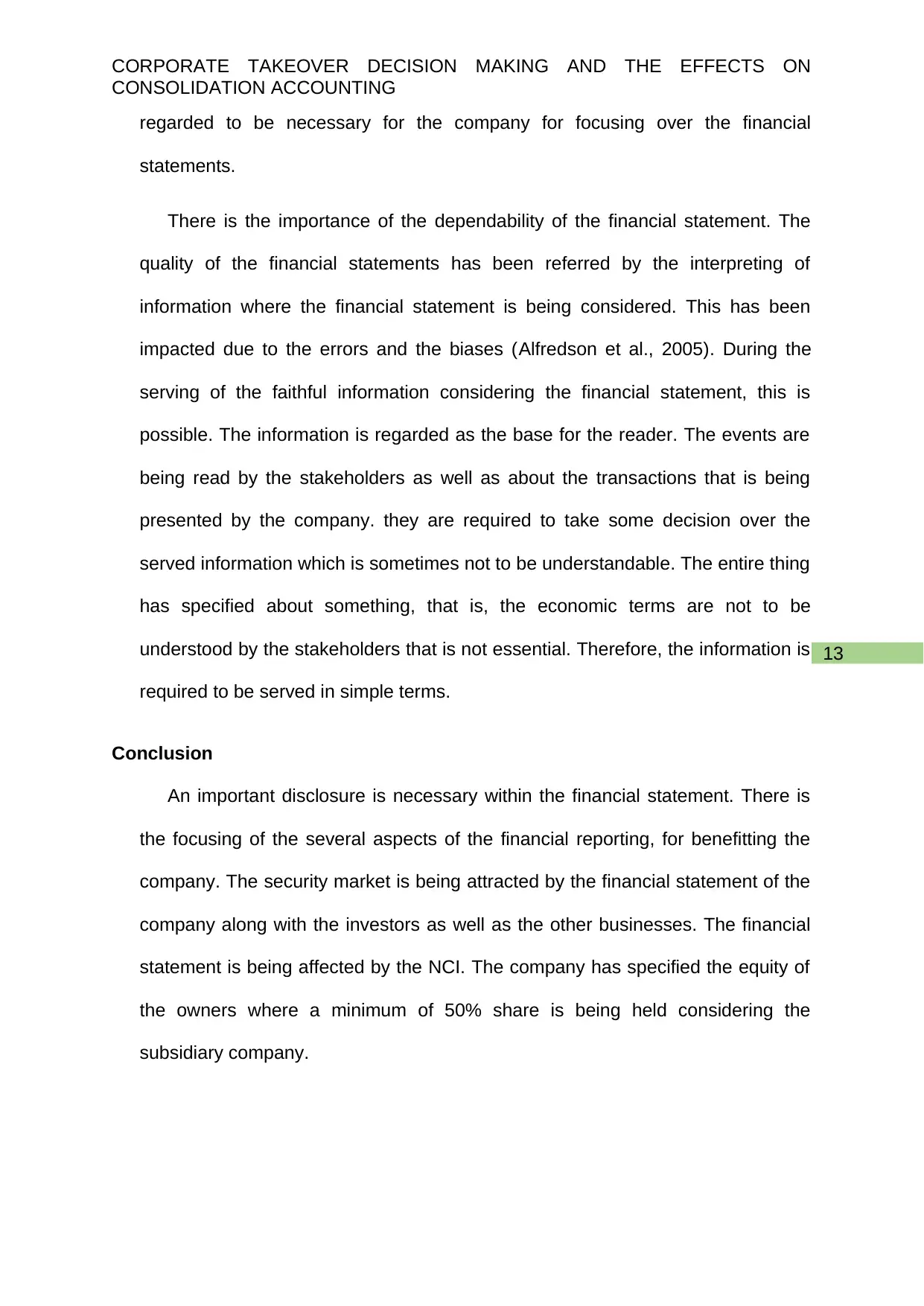
13
CORPORATE TAKEOVER DECISION MAKING AND THE EFFECTS ON
CONSOLIDATION ACCOUNTING
regarded to be necessary for the company for focusing over the financial
statements.
There is the importance of the dependability of the financial statement. The
quality of the financial statements has been referred by the interpreting of
information where the financial statement is being considered. This has been
impacted due to the errors and the biases (Alfredson et al., 2005). During the
serving of the faithful information considering the financial statement, this is
possible. The information is regarded as the base for the reader. The events are
being read by the stakeholders as well as about the transactions that is being
presented by the company. they are required to take some decision over the
served information which is sometimes not to be understandable. The entire thing
has specified about something, that is, the economic terms are not to be
understood by the stakeholders that is not essential. Therefore, the information is
required to be served in simple terms.
Conclusion
An important disclosure is necessary within the financial statement. There is
the focusing of the several aspects of the financial reporting, for benefitting the
company. The security market is being attracted by the financial statement of the
company along with the investors as well as the other businesses. The financial
statement is being affected by the NCI. The company has specified the equity of
the owners where a minimum of 50% share is being held considering the
subsidiary company.
CORPORATE TAKEOVER DECISION MAKING AND THE EFFECTS ON
CONSOLIDATION ACCOUNTING
regarded to be necessary for the company for focusing over the financial
statements.
There is the importance of the dependability of the financial statement. The
quality of the financial statements has been referred by the interpreting of
information where the financial statement is being considered. This has been
impacted due to the errors and the biases (Alfredson et al., 2005). During the
serving of the faithful information considering the financial statement, this is
possible. The information is regarded as the base for the reader. The events are
being read by the stakeholders as well as about the transactions that is being
presented by the company. they are required to take some decision over the
served information which is sometimes not to be understandable. The entire thing
has specified about something, that is, the economic terms are not to be
understood by the stakeholders that is not essential. Therefore, the information is
required to be served in simple terms.
Conclusion
An important disclosure is necessary within the financial statement. There is
the focusing of the several aspects of the financial reporting, for benefitting the
company. The security market is being attracted by the financial statement of the
company along with the investors as well as the other businesses. The financial
statement is being affected by the NCI. The company has specified the equity of
the owners where a minimum of 50% share is being held considering the
subsidiary company.
Paraphrase This Document
Need a fresh take? Get an instant paraphrase of this document with our AI Paraphraser
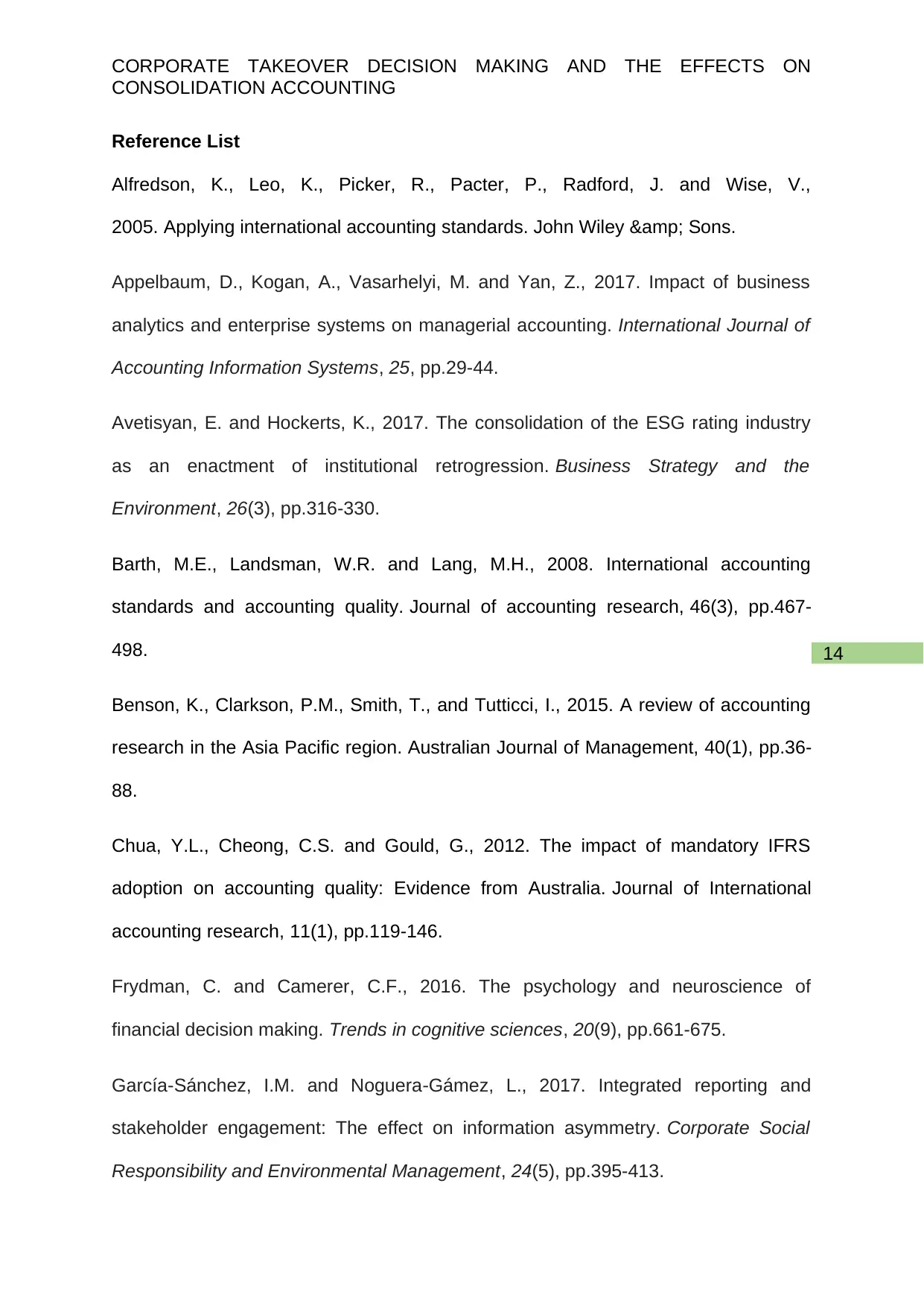
14
CORPORATE TAKEOVER DECISION MAKING AND THE EFFECTS ON
CONSOLIDATION ACCOUNTING
Reference List
Alfredson, K., Leo, K., Picker, R., Pacter, P., Radford, J. and Wise, V.,
2005. Applying international accounting standards. John Wiley & Sons.
Appelbaum, D., Kogan, A., Vasarhelyi, M. and Yan, Z., 2017. Impact of business
analytics and enterprise systems on managerial accounting. International Journal of
Accounting Information Systems, 25, pp.29-44.
Avetisyan, E. and Hockerts, K., 2017. The consolidation of the ESG rating industry
as an enactment of institutional retrogression. Business Strategy and the
Environment, 26(3), pp.316-330.
Barth, M.E., Landsman, W.R. and Lang, M.H., 2008. International accounting
standards and accounting quality. Journal of accounting research, 46(3), pp.467-
498.
Benson, K., Clarkson, P.M., Smith, T., and Tutticci, I., 2015. A review of accounting
research in the Asia Pacific region. Australian Journal of Management, 40(1), pp.36-
88.
Chua, Y.L., Cheong, C.S. and Gould, G., 2012. The impact of mandatory IFRS
adoption on accounting quality: Evidence from Australia. Journal of International
accounting research, 11(1), pp.119-146.
Frydman, C. and Camerer, C.F., 2016. The psychology and neuroscience of
financial decision making. Trends in cognitive sciences, 20(9), pp.661-675.
García‐Sánchez, I.M. and Noguera‐Gámez, L., 2017. Integrated reporting and
stakeholder engagement: The effect on information asymmetry. Corporate Social
Responsibility and Environmental Management, 24(5), pp.395-413.
CORPORATE TAKEOVER DECISION MAKING AND THE EFFECTS ON
CONSOLIDATION ACCOUNTING
Reference List
Alfredson, K., Leo, K., Picker, R., Pacter, P., Radford, J. and Wise, V.,
2005. Applying international accounting standards. John Wiley & Sons.
Appelbaum, D., Kogan, A., Vasarhelyi, M. and Yan, Z., 2017. Impact of business
analytics and enterprise systems on managerial accounting. International Journal of
Accounting Information Systems, 25, pp.29-44.
Avetisyan, E. and Hockerts, K., 2017. The consolidation of the ESG rating industry
as an enactment of institutional retrogression. Business Strategy and the
Environment, 26(3), pp.316-330.
Barth, M.E., Landsman, W.R. and Lang, M.H., 2008. International accounting
standards and accounting quality. Journal of accounting research, 46(3), pp.467-
498.
Benson, K., Clarkson, P.M., Smith, T., and Tutticci, I., 2015. A review of accounting
research in the Asia Pacific region. Australian Journal of Management, 40(1), pp.36-
88.
Chua, Y.L., Cheong, C.S. and Gould, G., 2012. The impact of mandatory IFRS
adoption on accounting quality: Evidence from Australia. Journal of International
accounting research, 11(1), pp.119-146.
Frydman, C. and Camerer, C.F., 2016. The psychology and neuroscience of
financial decision making. Trends in cognitive sciences, 20(9), pp.661-675.
García‐Sánchez, I.M. and Noguera‐Gámez, L., 2017. Integrated reporting and
stakeholder engagement: The effect on information asymmetry. Corporate Social
Responsibility and Environmental Management, 24(5), pp.395-413.

15
CORPORATE TAKEOVER DECISION MAKING AND THE EFFECTS ON
CONSOLIDATION ACCOUNTING
Gatta, V. and Marcucci, E., 2016. Stakeholder-specific data acquisition and urban
freight policy evaluation: evidence, implications and new suggestions. Transport
Reviews, 36(5), pp.585-609.
Graham, J.R., Hanlon, M., Shevlin, T. and Shroff, N., 2017. Tax rates and corporate
decision-making. The Review of Financial Studies, 30(9), pp.3128-3175.
Greve, H.R. and Man Zhang, C., 2017. Institutional logics and power sources:
Merger and acquisition decisions. Academy of Management Journal, 60(2), pp.671-
694.
Ikeda, N., Inoue, K. and Watanabe, S., 2018. Enjoying the quiet life: Corporate
decision-making by entrenched managers. Journal of the Japanese and
International Economies, 47, pp.55-69.
Mohamad, A., Zainuddin, Y., Alam, N. and Kendall, G., 2017. Does decentralized
decision making increase company performance through its Information Technology
infrastructure investment?. International Journal of Accounting Information
Systems, 27, pp.1-15.
Osadchy, E.A., Akhmetshin, E.M., Amirova, E.F., Bochkareva, T.N., Gazizyanova,
Y.Y. and Yumashev, A.V., 2018. Financial statements of a company as an
information base for decision-making in a transforming economy. European
Research Studies Journal, 21(2), pp.339-350.
Picker, R., Clark, K., Dunn, J., Kolitz, D., Levine, G., Loftus, J. and Van der Tas, L.,
2016. Applying IFRS standards. John Wiley & Sons.
Puranam, P. and Vanneste, B., 2016. Corporate strategy: Tools for analysis and
decision-making. Cambridge University Press.
CORPORATE TAKEOVER DECISION MAKING AND THE EFFECTS ON
CONSOLIDATION ACCOUNTING
Gatta, V. and Marcucci, E., 2016. Stakeholder-specific data acquisition and urban
freight policy evaluation: evidence, implications and new suggestions. Transport
Reviews, 36(5), pp.585-609.
Graham, J.R., Hanlon, M., Shevlin, T. and Shroff, N., 2017. Tax rates and corporate
decision-making. The Review of Financial Studies, 30(9), pp.3128-3175.
Greve, H.R. and Man Zhang, C., 2017. Institutional logics and power sources:
Merger and acquisition decisions. Academy of Management Journal, 60(2), pp.671-
694.
Ikeda, N., Inoue, K. and Watanabe, S., 2018. Enjoying the quiet life: Corporate
decision-making by entrenched managers. Journal of the Japanese and
International Economies, 47, pp.55-69.
Mohamad, A., Zainuddin, Y., Alam, N. and Kendall, G., 2017. Does decentralized
decision making increase company performance through its Information Technology
infrastructure investment?. International Journal of Accounting Information
Systems, 27, pp.1-15.
Osadchy, E.A., Akhmetshin, E.M., Amirova, E.F., Bochkareva, T.N., Gazizyanova,
Y.Y. and Yumashev, A.V., 2018. Financial statements of a company as an
information base for decision-making in a transforming economy. European
Research Studies Journal, 21(2), pp.339-350.
Picker, R., Clark, K., Dunn, J., Kolitz, D., Levine, G., Loftus, J. and Van der Tas, L.,
2016. Applying IFRS standards. John Wiley & Sons.
Puranam, P. and Vanneste, B., 2016. Corporate strategy: Tools for analysis and
decision-making. Cambridge University Press.
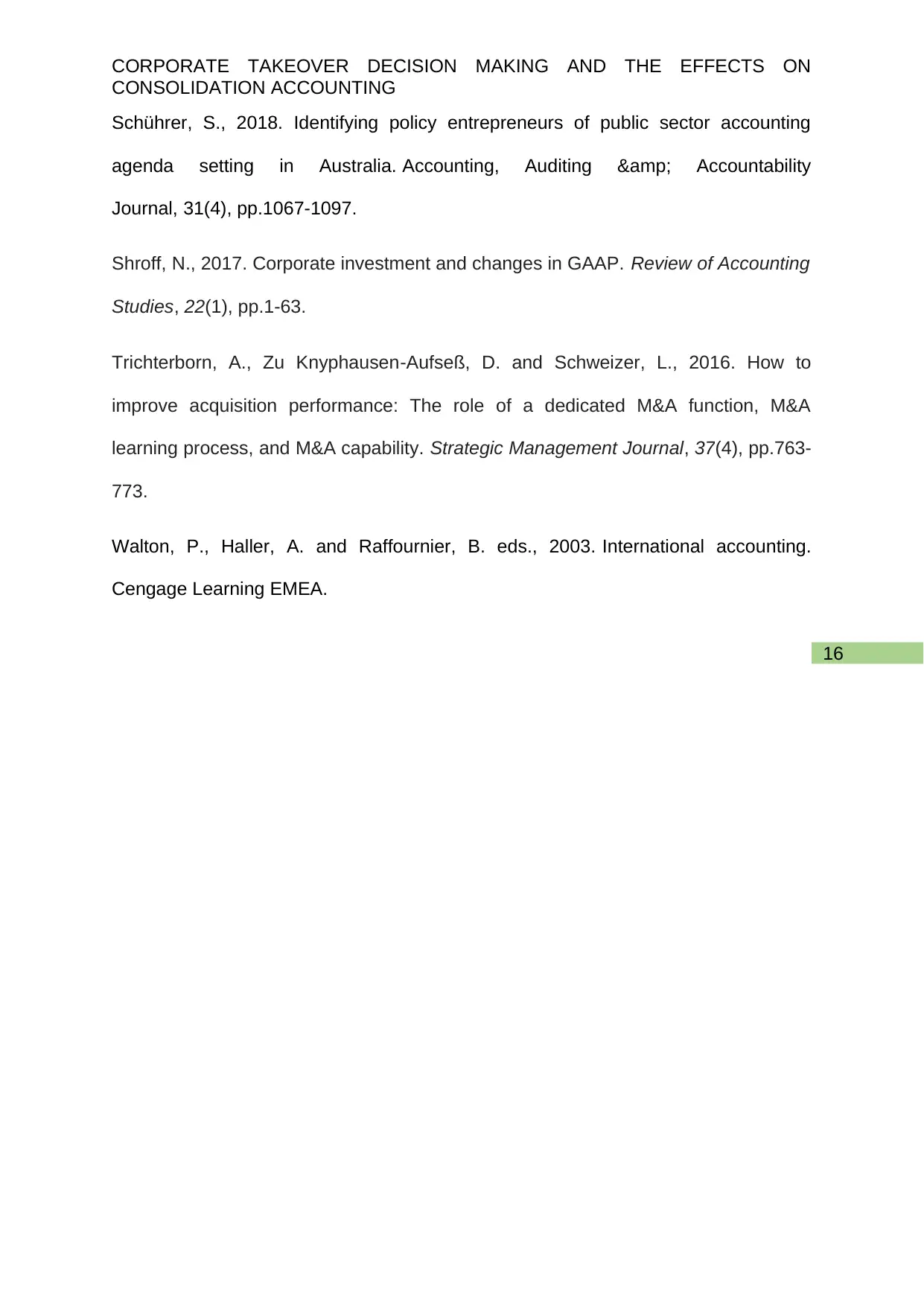
16
CORPORATE TAKEOVER DECISION MAKING AND THE EFFECTS ON
CONSOLIDATION ACCOUNTING
Schührer, S., 2018. Identifying policy entrepreneurs of public sector accounting
agenda setting in Australia. Accounting, Auditing & Accountability
Journal, 31(4), pp.1067-1097.
Shroff, N., 2017. Corporate investment and changes in GAAP. Review of Accounting
Studies, 22(1), pp.1-63.
Trichterborn, A., Zu Knyphausen‐Aufseß, D. and Schweizer, L., 2016. How to
improve acquisition performance: The role of a dedicated M&A function, M&A
learning process, and M&A capability. Strategic Management Journal, 37(4), pp.763-
773.
Walton, P., Haller, A. and Raffournier, B. eds., 2003. International accounting.
Cengage Learning EMEA.
CORPORATE TAKEOVER DECISION MAKING AND THE EFFECTS ON
CONSOLIDATION ACCOUNTING
Schührer, S., 2018. Identifying policy entrepreneurs of public sector accounting
agenda setting in Australia. Accounting, Auditing & Accountability
Journal, 31(4), pp.1067-1097.
Shroff, N., 2017. Corporate investment and changes in GAAP. Review of Accounting
Studies, 22(1), pp.1-63.
Trichterborn, A., Zu Knyphausen‐Aufseß, D. and Schweizer, L., 2016. How to
improve acquisition performance: The role of a dedicated M&A function, M&A
learning process, and M&A capability. Strategic Management Journal, 37(4), pp.763-
773.
Walton, P., Haller, A. and Raffournier, B. eds., 2003. International accounting.
Cengage Learning EMEA.
1 out of 16
Related Documents
Your All-in-One AI-Powered Toolkit for Academic Success.
+13062052269
info@desklib.com
Available 24*7 on WhatsApp / Email
![[object Object]](/_next/static/media/star-bottom.7253800d.svg)
Unlock your academic potential
© 2024 | Zucol Services PVT LTD | All rights reserved.





